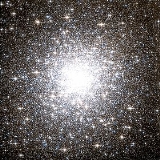
Messier 2
Encyclopedia
Messier 2 or M2 is a globular cluster
in the constellation
Aquarius
, five degrees north of the star
Beta Aquarii
. It was discovered by Jean-Dominique Maraldi in 1746 and is one of the largest known globular clusters.
. Charles Messier
rediscovered it in 1760 but thought it a nebula
without any stars associated with it. William Herschel
was the first to resolve individual stars in the cluster, in 1783.
M2 is, under extremely good conditions, just visible to the naked eye. Binoculars
or small telescope
s will identify this cluster as non-stellar while larger telescopes will resolve individual stars, of which the brightest are of apparent magnitude
13.1.
s away from Earth. At 175 light-years in diameter, it is one of the larger globular clusters known. The cluster is rich, compact, and significantly elliptical. It is 13 billion years old and one of the older globulars associated with the Milky Way Galaxy.
M2 contains about 150,000 stars, including 21 known variable stars. Its brightest stars are red and yellow giants
. The overall spectral type
is F4.
Globular cluster
A globular cluster is a spherical collection of stars that orbits a galactic core as a satellite. Globular clusters are very tightly bound by gravity, which gives them their spherical shapes and relatively high stellar densities toward their centers. The name of this category of star cluster is...
in the constellation
Constellation
In modern astronomy, a constellation is an internationally defined area of the celestial sphere. These areas are grouped around asterisms, patterns formed by prominent stars within apparent proximity to one another on Earth's night sky....
Aquarius
Aquarius (constellation)
Aquarius is a constellation of the zodiac, situated between Capricornus and Pisces. Its name is Latin for "water-bearer" or "cup-bearer", and its symbol is , a representation of water....
, five degrees north of the star
Star
A star is a massive, luminous sphere of plasma held together by gravity. At the end of its lifetime, a star can also contain a proportion of degenerate matter. The nearest star to Earth is the Sun, which is the source of most of the energy on Earth...
Beta Aquarii
Beta Aquarii
Beta Aquarii is a triple star in the constellation Aquarius. It has the traditional name Sadalsuud, from an Arabic expression سعد السعود sa‘d al-su‘ūd, the "luck of lucks"...
. It was discovered by Jean-Dominique Maraldi in 1746 and is one of the largest known globular clusters.
Discovery and visibility
M2 was discovered by the French astronomer Jean-Dominique Maraldi in 1746 while observing a comet with Jacques CassiniJacques Cassini
Jacques Cassini was a French astronomer, son of the famous Italian astronomer Giovanni Domenico Cassini.Cassini was born at the Paris Observatory. Admitted at the age of seventeen to membership of the French Academy of Sciences, he was elected in 1696 a fellow of the Royal Society of London, and...
. Charles Messier
Charles Messier
Charles Messier was a French astronomer most notable for publishing an astronomical catalogue consisting of deep sky objects such as nebulae and star clusters that came to be known as the 110 "Messier objects"...
rediscovered it in 1760 but thought it a nebula
Nebula
A nebula is an interstellar cloud of dust, hydrogen gas, helium gas and other ionized gases...
without any stars associated with it. William Herschel
William Herschel
Sir Frederick William Herschel, KH, FRS, German: Friedrich Wilhelm Herschel was a German-born British astronomer, technical expert, and composer. Born in Hanover, Wilhelm first followed his father into the Military Band of Hanover, but emigrated to Britain at age 19...
was the first to resolve individual stars in the cluster, in 1783.
M2 is, under extremely good conditions, just visible to the naked eye. Binoculars
Binoculars
Binoculars, field glasses or binocular telescopes are a pair of identical or mirror-symmetrical telescopes mounted side-by-side and aligned to point accurately in the same direction, allowing the viewer to use both eyes when viewing distant objects...
or small telescope
Telescope
A telescope is an instrument that aids in the observation of remote objects by collecting electromagnetic radiation . The first known practical telescopes were invented in the Netherlands at the beginning of the 1600s , using glass lenses...
s will identify this cluster as non-stellar while larger telescopes will resolve individual stars, of which the brightest are of apparent magnitude
Apparent magnitude
The apparent magnitude of a celestial body is a measure of its brightness as seen by an observer on Earth, adjusted to the value it would have in the absence of the atmosphere...
13.1.
Characteristics
M2 is about 37,500 light-yearLight-year
A light-year, also light year or lightyear is a unit of length, equal to just under 10 trillion kilometres...
s away from Earth. At 175 light-years in diameter, it is one of the larger globular clusters known. The cluster is rich, compact, and significantly elliptical. It is 13 billion years old and one of the older globulars associated with the Milky Way Galaxy.
M2 contains about 150,000 stars, including 21 known variable stars. Its brightest stars are red and yellow giants
Giant star
A giant star is a star with substantially larger radius and luminosity than a main sequence star of the same surface temperature. Typically, giant stars have radii between 10 and 100 solar radii and luminosities between 10 and 1,000 times that of the Sun. Stars still more luminous than giants are...
. The overall spectral type
Stellar classification
In astronomy, stellar classification is a classification of stars based on their spectral characteristics. The spectral class of a star is a designated class of a star describing the ionization of its chromosphere, what atomic excitations are most prominent in the light, giving an objective measure...
is F4.

